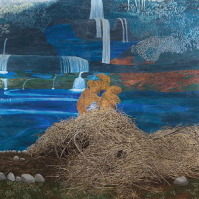Mary Lattimore
At The Dam
Mary Lattimore#s music functions as a kind of emotional synesthesia. Rather than seeing colours when she hears notes, Lattimore feels things sadness, hope, longing, memory. She funnels all of that into stirring songs composed on her harp. #I feel like a lot of my music is me channeling feelings or memories,# she says. #I just do whatever I want, and try to paint a picture of a memory.# The memory that provides the basis for At the Dam is particularly striking. Lattimore received a prestigious fellowship from the Pew Center for Arts & Heritage # a rare honor given out to just 12 people every year # and she used the funds to take a road trip across America with a friend, writing and recording songs at each stop along the way. Armed with little more than her harp and her laptop, Lattimore drew inspiration from each location, letting the environments in which she recorded seep into her work. The result is music that is stirring, delicate and beautiful, Lattimore#s harp at times bright and skipping, other times distant and hazy, swathed in gauzy delay. The net e#ect feels like what it is, recreations of moments from the past, tender, soft and warm. Lattimore#s experience with the harp began early. Her mother is a classical harpist, and Lattimore herself began taking lessons when she was 11. #There#s a lot of potential for experimentation with the harp,# she explains. #Also, you#re sort of hugging it when you play it. It#s resting on you. It#s very personal. The sounds are really warm and the vibrations are right there.# She soon found herself collaborating with musicians including Kurt Vile, Arcade Fire, and Thurston Moore, applying her signature style to their songs. But it was playing with Fursaxa that most expanded Lattimore#s horizons. #I was thinking about looping and layering, and watchng what she was doing with her vocals and keyboards, where she almost made it into a one woman band # that was really important.# All of that experience comes through on At the Dam, Lattimore#s most fully-realized e#ort to date. #A lot of the record was recorded at Joshua Tree,# she explains. #I would take the harp, wheel it out on to the porch and I had the whole desert around me. I was in the middle of nowhere with the harp, and just recorded there.# Lattimore also recorded in Marfa, Texas at a friend#s house, as well as in the mountains, in what Lattimore describes as #a beautiful, mid-century guesthouse.# The through-line between all of the locations is that they#re far from Lattimore#s Philadelpha home, and that she was alone during the entire recording process. No matter their subjects, At the Dam treats each one beautifully on #Jaxine Drive,# guitars sigh low and sorrowful beneath Lattimore#s sparkling harp. #Ferris Wheel, January,# is Lattimore at her most overtly tuneful, notes drifting down like gentle snow, softly sparkling, creating a quiet, wandering melody. At the Dam settles in like a spell, each note drawing you deeper into its trance. #It#s a travel diary,# explains Lattimore, #A chunk of my life that I got to record and that hopefully speaks to people. The title of the record came from this beautiful essay by Joan Didion, #At the Dam,# about her the Hoover Dam. She thinks about how the Hoover Dam will keep working, even when humans aren#t around.# Like memories, it continues long after the moments that caused them are over. At the Dam is a rich snapshot of those fleeting moments.
Tracklist
1. Otis Walks Into The Woods
2. Jimmy V
3. The Quiet at Night
4. Jaxine Drive
5. Ferris Wheel, January
















































































